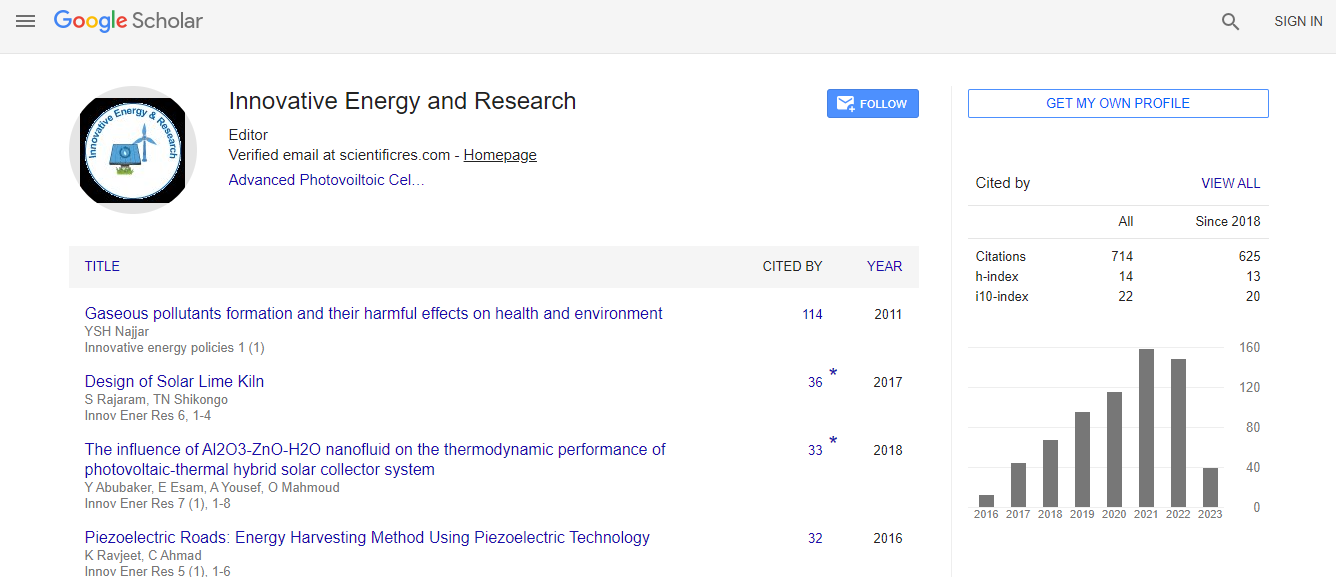Our Group organises 3000+ Global Conferenceseries Events every year across USA, Europe & Asia with support from 1000 more scientific Societies and Publishes 700+ Open Access Journals which contains over 50000 eminent personalities, reputed scientists as editorial board members.
Open Access Journals gaining more Readers and Citations
700 Journals and 15,000,000 Readers Each Journal is getting 25,000+ Readers
Google Scholar citation report
Citations : 712
Innovative Energy & Research received 712 citations as per Google Scholar report
Innovative Energy & Research peer review process verified at publons
Indexed In
- Google Scholar
- Open J Gate
- Genamics JournalSeek
- RefSeek
- Hamdard University
- EBSCO A-Z
- Publons
- Euro Pub
- ICMJE
Useful Links
Recommended Journals
Related Subjects
Share This Page
Development of new bi-functional dense ceramic-carbonate membrane reactors for CO oxidation and subsequent CO2 permeation
Joint Event on 2nd International Conference on Renewable Energy and Resources & Energy Materials and Fuel Cell Research
Pedro Sanchez-Camacho, Oscar Ovalle-Encinia and Heriberto Pfeiffer
National Autonomous University of Mexico, Mexico
Posters & Accepted Abstracts: Innov Ener Res
Abstract
Gas separation processes have become one of the most promising strategies for different industrial applications; carbon dioxide (CO2) and carbon monoxide (CO) separation among them. Within this context, syngas is composed of hydrogen and carbon oxides, and it is usually produced at high temperatures. Therefore, H2 enrichment, through the carbon oxides separation is of great interest. On CO2 separation, different membrane systems have been developed, including zeolites, polymers, and ceramics. Especially, the so-called dense dual-phase membranes have shown very interestingly CO2 separation properties at high temperatures. This kind of membrane systems is produced by a porous solid support infiltrated with molten carbonates, where ceramic supports must ideally have oxygen ionic and electronic conductive properties. CO2 permeation is performed by the reaction of oxygen ions from the ceramic oxide with the CO2 present on the upstream side, producing carbonate ions, which diffuse through the molten carbonate phase due to CO2 partial pressure gradients on both membrane sides. CO2 is desorbed on the downstream side through the reversible decarbonation process and swept from the surface. Oxygen ions are reincorporated and diffused on the ceramic phase as a consequence of decarbonization. Since perovskites have good ionic-electronic conduction properties, some of them have been incorporated to dense ceramic-carbonate membranes, increasing CO2 permeation. In this work, a composite (doped ceria and perovskite) was synthesized, sintered and infiltrated with molten carbonates, showing that it is able to perform both processes; the CO oxidation at the surface and subsequent CO2 permeation through the molten carbonate phase. CO conversion and CO2 recovery efficiencies were 39.6 and 64.6% at 900 °C, respectively. Moreover, results in evidence that the perovskite phase importantly improve the oxygen permeation from sweep to feed side (inverse permeation), enhancing CO oxidation and CO3 2-formation, without releasing oxygen on the feed side.Biography
Pedro Sanchez-Camacho received a Chemistry´s degree from the Universidad Nacional Autónoma de Mexico (UNAM) in 2012. Later, he obtained a master´s degree in Material Science and Engineering in same University. Nowadays, he studies a PhD in a Materials Science and Engineering focusing in the development of ceramic oxide membranes in order to separate CO2 from a gas mixture. He is especially interested in solid state chemistry, ceramic synthesis, sorption processes on ceramics, catalysis, inorganic membranes for gas separation and solid oxide fuel cells (SOFC´s). As part of his work, some papers have been published on referred journals such as Journal of Physical Chemistry and Journal of Energy Chemistry, among others.
E-mail: pedsacam@gmail.com

 Spanish
Spanish  Chinese
Chinese  Russian
Russian  German
German  French
French  Japanese
Japanese  Portuguese
Portuguese  Hindi
Hindi 
